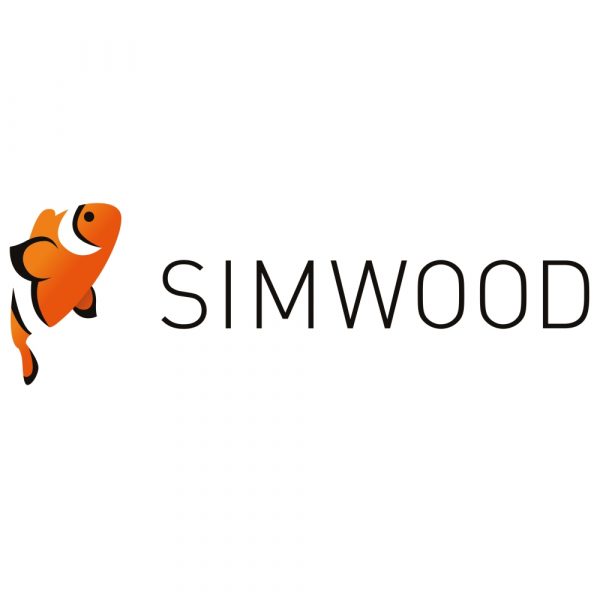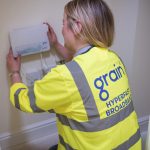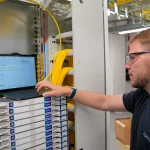SIMWOOD Prepare Uncontended FTTP and FTTC Connections

Wholesale communications provider SIMWOOD UK, which supplies business and ISPs, appears to have developed a new set of uncontended FTTC and FTTP based products aimed at home workers and smaller businesses. Just don’t call their packages “broadband,” even though they kind of still are.. a bit.
We tend not to cover the wholesale (ISP supplier) side of things too much on ISPreview.co.uk – we’re more focused on the consumer and layer 1 network infrastructure sides, unless a provider does something interesting enough to entice our gaze and that may well be the case today.
At present SIMWOOD already sells Ethernet and internet access services, albeit usually at the higher end of the speed range (1Gbps or nowadays 10Gbps) and always via optical (fibre) delivery methods. The provider now seems to be adding data-only Fibre-to-the-Cabinet (FTTC) and Fibre-to-the-Premises (FTTP) solutions into the mix directly via Openreach’s network.
Advertisement
Despite this the provider is keen to stress that they “will not be selling broadband” because they instead intend to offer these alongside “100% provisioned capacity, all the time” (i.e. uncontended), which is closer to an Ethernet mould of service delivery.
Simon Woodhead, SIMWOOD, said:
“In short, we’re not offering broadband, we’re offering ethernet. We’re working directly with those who own infrastructure and can offer wholesale access, (many of them are customers already), and of course BT who have the largest footprint. To emphasise, we’re dealing directly; we’re not using aggregators or middle-men, so Simwood is in control of the experience as far as possible, short of us rolling out our own national FTTP programme.
End-user tails will be delivered over FTTP where on-net, but we’ll also be using FTTC. FTTC enables the delivery of ethernet to an end-user with a wall-port change. So whilst there is an engineer visit required, the end user gets ethernet. Key point though: this is distinct to existing EoFTTC offerings in the market which backhaul over a shared broadband network; with Simwood EoFTTC it is un-contended all the way.
For FTTP, we’re offering speeds up to 1Gb/s down, 220Mb/s up. With FTTC we’re offering 80Mb/s down and 20Mb/s up, but given the last mile isn’t fibre, this’ll be subject to a speed estimate and after installation a speed limit based on monitoring. But don’t compare these speeds to broadband; this is ethernet, all uncontended right back to the Simwood core, and of course across it.”
In fairness we should point out that “broadband” tends to reflect a very general term, using a wide bandwidth data transmission (via radio or light etc.), for a high-speed internet connection that is “always on“. At the end of the day there is no singular or widely agreed definition of what broadband should represent, which means that at its most basic level you can apply the definition to lots of different data connection types (contended or not).
Anyway, the above is all semantics, and what matters here is that SIMWOOD have launched an interesting new product set. The provider is currently still developing this and as such they’re looking for early adopters to “engage with us and have meaningful conversations around disruptive price points, and template configurations” (i.e. customer trials).
The catch for end-users is that you can’t easily do a truly uncontended broadband service without the final product being a fair bit more expensive than a typical domestic grade business connection, which could put it out of reach for some regular home workers. Credits to one of our readers, Tom, for spotting this development.
Advertisement
Mark is a professional technology writer, IT consultant and computer engineer from Dorset (England), he also founded ISPreview in 1999 and enjoys analysing the latest telecoms and broadband developments. Find me on X (Twitter), Mastodon, Facebook, BlueSky, Threads.net and Linkedin.
« Government Preps Universal Service Obligation for UK Mobile
EE UK Launch First Own Brand 5G WiFi Mobile Broadband Router »






















































How is the capacity from the cabinet to the exchange (for FTTC) managed? Is this a separate link, or does it take priority over the existing links, or does it only take priority/sent down it own route from the exchange?
If it’s the last instance, what would happen if the current cabinet > exchange links are all being fully utilised (rare I am sure, but not impossible if from what I had read the maximum link from a cabinet to exchange is 6x1Gb links. With 384 lines that equates to c.15.6Mb per line.
Nice to see some wholesale articles, very interesting.
Sounds great but Openreach FTTP is contended with up to 32 people sharing 2.5 down and 1.25 up, so it is contended, it may not be showing congestion in many places due to lower take up and lower speed packages being bought, but it is contended. Similarly an FTTC cabinet is contended with possibly hundreds of customers sharing a much smaller pipe back to the exchange than the combined total of connections.
Of course it maybe reading the terms and conditions and small print the above is spelt out and the “uncontended” part is only applicable to their own network and peering, which of course isn’t quite the same thing and not an unusual thing to be stated by an ISP.
My ONT provides an Ethernet connection, and so does a VDSL modem/router, so again, what is the unique selling point here. Reads like great PR and a great advert for the company, but when it boils down to it, what is really different about it?
Doesn’t the quote in the article answer that?
“Key point though: this is distinct to existing EoFTTC offerings in the market which backhaul over a shared broadband network; with Simwood EoFTTC it is un-contended all the way.”
I’ve always found the EoFTTC products a little underwhelming in that only 20Mb down is guaranteed and between 20Mb and whatever max speed your line is capable of is delivered on a burst/best endeavors basis. If you had a line capable of 80Mb and EoFTTC could give you the full speed of your line on an uncontended basis, that is potentially a much more interesting product (for my purposes anyway) and something I’d be prepared to pay for.
How much FTTC 80/20 uncontended for residential customer?
Guess it depends if its broadband or Ethernet? :/
Dunno,. But Talk Talk Business are doing 20% off Black Friday and apparently E0FTTC is £60 a month..
Surprised with Simon’s press release as they are usually on their A-game with the detail. Unless they have not provided all the detail yet? 😉
Both FTTC and FTTP operate over a shared PON network if they are using Openreach for the access tails, which I am sure they will be in the main.
Therefore there is no technical way they can provide uncontended bandwidth for those headline rates they are mentioning. E.g. if they provide an FTTP 1Gb/220Mb circuit, there is no way they can provide uncontended 1Gb/220Mb, as the PON could have 32 customers, and there’s a shared 2.4Gb down, 1.2Gb up per PON. Obviously if the PON is quiet, then they may get away with it.
Openreach have SIN documentation which provides PIR and CIR rates for FTTP/C, so they could at least quote the CIR rates as the ‘uncontended rate’.
But technically, Ethernet handoff offers way more flexibility for a variety of things, aside from the potential for less contention.
So this service is definitely a plus over standard FTTP/C for those that need this.
“Both FTTC and FTTP operate over a shared PON network if they are using Openreach for the access tails, which I am sure they will be in the main.”
FTTC (both VDSL2 & G.Fast) aren’t PON’s.
They are indeed contended links between the DSLAM’s in the cabinets and the OLT/Head-End) in the exchange.
They can add more 1Gb links for the VDSL DSLAM’s and the G.Fast pods already use 10Gb links.
If necessary i believe they can upgrade the VDSL to OLT links to 10Gb but that’s no small task.
Matthew is correct. FTTC cabs are largely unlinked to the exchange on PONs, not 1g AE like you suggest.
Great to see Simwood getting involved in the Broadband err sorry Ethernet world. Great company and if someone can bring together all the Altnets as well as Openreach services then would be useful.
Good luck.
*that* even
Umm
https://www.ispreview.co.uk/index.php/2020/09/bt-launch-uk-ethernet-fttp-service-for-wholesale-customers.html
Reading the update on that article on how BTW would supply an uncontended product seems to say they actually don’t, but using many more words than necessary to avoid outright saying it. Basically the priority of a customer on such a product is higher than everyone else on the PON. Of course that fails to work when you have several on the same PON all having the same high priority with a fast product. Perhaps Openreach are prepared, when the customer notices their product is slowing down at peak times, to pop round and use a spare fibre and create another GPON and split them off onto that, and/or will look to upgrade to XG-GPON in time.
So these products are indeed contended but just prioritised, and so don’t have a dedicated uncontended connection in the same way a true leased line would, and basically are sold on the hope that the splitter isn’t busy and most people are on slower products or not at home, essentially exactly the same as it is now!
@Phil: If there are 6x1Gb links from the cabinet to the exchange (taken from the comment by gary333 above), and each of those would normally take upto 32 customers, then you could use that technique to sell 6 “uncontended” lines, plus 186 (31*6) contended lines. The customers on the contended lines might have problems if your priority traffic swamps theirs, but that’s a normal contention problem.
@Ian Tommins my comments were relating more to FTTP which is 32 properties sharing just 2.5 down/1.25 up, there is a lot less bandwidth to play with. Presumably Openreach when connecting into more commercial type properties don’t use the full 32 per single fibre split and have extra fibres ready to add more capacity to provide something that appears uncontended should the need arise and quite quickly, but as no information is forthcoming how Openreach will guarantee this “uncontended” product on a potentially heavily contended single fibre, quite rightly we ask questions and wonder about it.
Yup but somewhere in the chain it becomes contended at some point.
It is a question of reaching as far as you can with traffic prioritisation.
As all the new OR FTTP installs are X-GPON, I think I’m right in saying OR have stopped putting plain GPON on poles and in the ground(?), isn’t this a somewhat reducing worry as the link is 10G?
Ok this is an issue on the older estate where legacy 2.5G is the limiting factor.
Is there any evidence of the 6 x 1G from DSLAM to Headend generally being the limiting factor in FTTC performance? I don’t see anyone bothering to upgrade this except where the fibre is being dual used for something else or being recycled into FTTP rollouts.
@abuilder Openreach still fit GPON, but the OLTs used (Nokia & Adtran) both support 10G & 40G PON overlay on top ( needs new CPE / ONT and OLT optic) so can coexist in same fibre as GPON
“It is a question of reaching as far as you can with traffic prioritisation.” Of course exactly true, and the issue here is the uncontended part is only a few metres until you reach your own ONT in your own home, and the contended part of the network is outside the control of the supplier selling an “uncontended” service.
GPON is still deployed as standard.